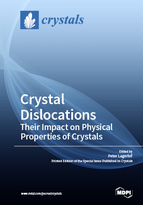Crystal Dislocations: Their Impact on Physical Properties of Crystals
A special issue of Crystals (ISSN 2073-4352). This special issue belongs to the section "Inorganic Crystalline Materials".
Deadline for manuscript submissions: closed (31 January 2018) | Viewed by 89827
Special Issue Editor
Interests: slip and twinning in ceramics and metals; X-ray diffraction; electron microscopy; microstructural development; mechanical properties
Special Issues, Collections and Topics in MDPI journals
Special Issue Information
Dear Colleagues,
The proposed existance of the edge and screw dislcoation, in the 1930s, and the subsequent work showing that dislocation theory could explain the plastic deformation of crystals, represent an important step in developing our understanding of materials into a science. The continued work involved with characterization of dislocations, and linking them to a variety of physical properties, in both single and poly crystals, have made enormous progress over the past 50 years. It is rare to find a technical application involving a material with any crystal structure that is not impacted by dislocations; mechanical properties, massive phase transformations, interphases, crystal growth, electronic properties, and the list goes on. In many systems, the properties are controlled by the formation of partial dislocations separated by a stacking fault; for example, plastic deformation via deformation twinning. Finally, giant strides have been made in characterization and modeling of systems containing dislcocations.
The Special Issue on Crystal Dislocations is intended to provide a unique international forum aimed at covering a broad range of results involving dislocations and their importance in crystal properties and crystal growth. Scientists working in a wide range of disciplines are invited to contribute to this cause.
The list of key words shown below cover only a limited range of areas in which dislocations play an intrical part; this Special Issue of Crystals is open for any innovative contributions involving dislocations.
Prof. Dr. K. Peter D. Lagerlof
Guest Editor
Manuscript Submission Information
Manuscripts should be submitted online at www.mdpi.com by registering and logging in to this website. Once you are registered, click here to go to the submission form. Manuscripts can be submitted until the deadline. All submissions that pass pre-check are peer-reviewed. Accepted papers will be published continuously in the journal (as soon as accepted) and will be listed together on the special issue website. Research articles, review articles as well as short communications are invited. For planned papers, a title and short abstract (about 100 words) can be sent to the Editorial Office for announcement on this website.
Submitted manuscripts should not have been published previously, nor be under consideration for publication elsewhere (except conference proceedings papers). All manuscripts are thoroughly refereed through a single-blind peer-review process. A guide for authors and other relevant information for submission of manuscripts is available on the Instructions for Authors page. Crystals is an international peer-reviewed open access monthly journal published by MDPI.
Please visit the Instructions for Authors page before submitting a manuscript. The Article Processing Charge (APC) for publication in this open access journal is 2600 CHF (Swiss Francs). Submitted papers should be well formatted and use good English. Authors may use MDPI's English editing service prior to publication or during author revisions.
Keywords
-
Crystal dislocations
-
Partial dislocations
-
Crystal defect structures and properties
-
Deformation twinning
-
Massive phase transformations
-
Characterization of dislocations
-
Crystal growth






